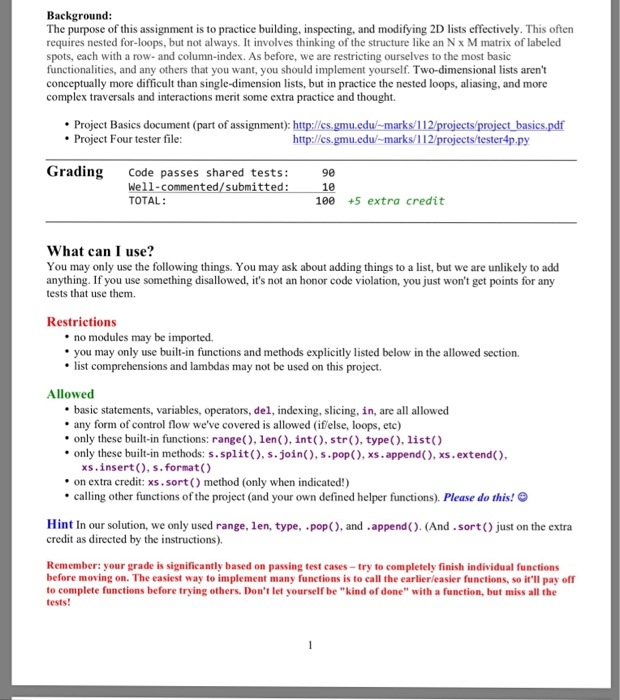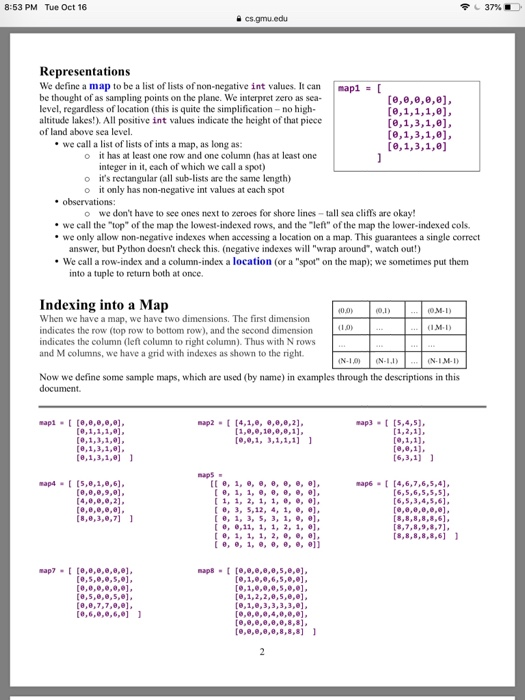Question
PYTHON CODING HELP. Lastly, these last functions. Need help with the following tasks. Map that may b referred to is in screenshot & so are
PYTHON CODING HELP. Lastly, these last functions. Need help with the following tasks. Map that may b referred to is in screenshot & so are restrictions & restraints.
Function 8:
def on_ridge(map, r, c): Given a map and a location, is that spot on a ridge? We define a ridge as a place that has two neighbors on opposite side that are both land and both lower than the spot itself. We consider sideto-side, above-and-below, as well as opposing diagonal neighbors as ways to show we are on a ridge. When the adjacent spot is off the map, it can't be used to claim we're on a ridge. If (r,c) isn't on the map, the answer is False.
Assume: map is a map as defined above, and r and c are int values.
on_ridge(map1,2,2) True
on_ridge(map6,1,3) False
on_ridge(map6,1,4) True
Function 9:
def is_peak(map, r, c): Given a map and a location, is it land and are all neighboring land spots lower than it? If the spot isn't on the map, it is not a peak. It's possible to have peaks on the border.
Assume: map is a map as defined above, and r and c are int values.
is_peak(map2,1,3) True
is_peak(map2,2,3) False
is_peak(map5,3,3) True
Function 10:
def join_map_side(map1, map2): Given two maps, create and return a new map by deep-copying map1 and map2 side by side for a longer map of the same height. If their heights don't match, return None.
Assume: map1 and map2 are maps as defined above. Remember, you must not modify the original maps.
join_map_side([[1,2],[5,6]], [[3,4],[7,8]]) [[1,2,3,4],[5,6,7,8]]
join_map_side([[1],[2],[3],[4]], [[5],[6],[7],[8]]) [[1,5],[2,6],[3,7],[4,8]]
join_map_side(m1,m2) None
Function 11:
def join_map_below(map1, map2): Given two maps, create and return a new map by deep-copying map1 and map2 one above the other for a taller map of the same width. If their widths don't match, return None.
Assume: map1 and map2 are maps as defined above. Remember, you must not modify the original maps.
join_map_below([[1,1],[2,2]], [[3,3],[4,4]]) [[1,1],[2,2],[3,3],[4,4]]
join_map_below([[1]], [[2]]) [[1],[2]]
join_map_below([[1,2],[3,4]], [[5,6,7,8]]) None
Function 12:
def crop(map, r1, c1, r2, c2): Given a map and two locations, create and return the map that only contains rows from r1 to r2 (inclusive), and columns from c1 to c2 (inclusive). If r1>r2 or c1>c2, the answer has no rows/columns (we return []). Similar to how slicing works, if more rows or columns are requested than exist, just return the parts that do exist. Remember, you must not modify the original map.
Assume: map is a map as defined above, and r1, r2, c1, and c2 are int values.
crop(map1,1,1,3,3) [[1,1,1],[1,3,1],[1,3,1]]
crop(map5,3,1,3,4) [[3,5,12,4]]
crop(map2,1,1,90,90) [[0,0,10,0,0,1],[0,1,3,1,1,1]]
crop(m1,2,2,1,3) []


Step by Step Solution
There are 3 Steps involved in it
Step: 1

Get Instant Access to Expert-Tailored Solutions
See step-by-step solutions with expert insights and AI powered tools for academic success
Step: 2

Step: 3

Ace Your Homework with AI
Get the answers you need in no time with our AI-driven, step-by-step assistance
Get Started


